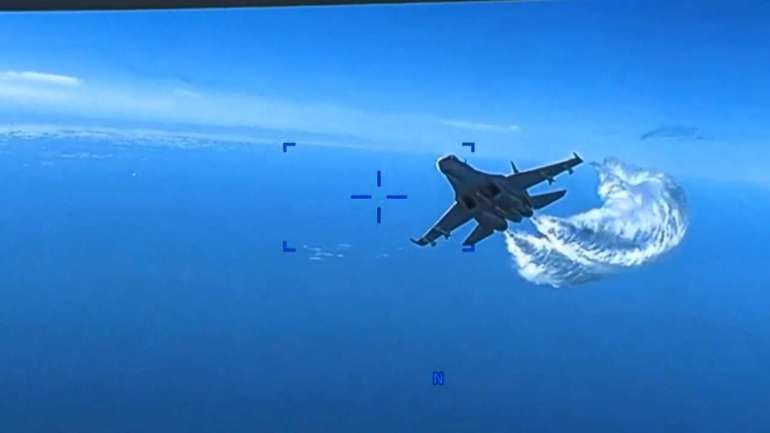Watch: New Pentagon video shows Russian fighter jet striking U.S. drone

U.S. operators were forced to ditch the uncrewed aircraft in the Black Sea after the propeller was struck. The U.S. said the Russian pilots were “reckless” and “unprofessional.” Russian officials denied responsibility for the crash, shifting blame to the drone’s pilots.
Despite the incident, the U.S. will continue conducting surveillance flights worldwide, Defense Secretary Lloyd Austin said Wednesday.
“Make no mistake, the United States will continue to fly and to operate wherever international law allows,” Austin said at the start of a virtual meeting of nations supporting Ukraine against Russia. “It is incumbent upon Russia to operate its military aircraft in a safe and professional manner.”
Austin singled out Moscow’s forces, calling the incident “a pattern of aggressive and risky, and unsafe actions by Russian pilots in international airspace.”
Risky behavior by Russia’s military has also ramped up in the Middle East in recent weeks, the commander of U.S. forces in the region told senators on Thursday.
While provocative behavior isn’t new, Central Command chief Gen. Michael Kurilla said there’s been “a significant spike” since the beginning of March in Syria, where Russia and the U.S. both maintain a military presence.
“What we are seeing, though, is an increase recently in the unprofessional and unsafe behavior of the Russian air force in the region,” Kurilla said at a Senate Armed Services Committee hearing.
“They fly over our bases with ground attack aircraft with weapons on them in an attempt to try and be provocative, but really it’s unsafe, unprofessional, not what we expect of a professional air force,” Kurilla testified. “They want to try to renegotiate the deconfliction protocols that they violate every day.”
Austin spoke with his Russian counterpart Sergei Shoigu on Wednesday about the incident, the first call between the two since October. During a Pentagon press briefing later in the day, he underscored the importance of communication to “help to prevent miscalculation going forward.”
“We know that the intercept was intentional. We know that the aggressive behavior was intentional,” Gen. Mark Milley, chair of the Joint Chiefs of Staff, said at the briefing. However, it’s unclear whether the fighter jet’s collision with the drone was intentional, he added.
The drone sank 4,000 to 5,000 feet into the waters, Milley said, making it difficult for Russia to retrieve the technology if it intends to.
“It probably broke up. There’s probably not a lot to recover,” he said, emphasizing that the military took “mitigating measures” to ensure there’s no sensitive intelligence aboard the drone.
The collision set off a diplomatic row Tuesday as American officials scrambled to speak with their Russian counterparts and voice concerns to Moscow.
Following the crash, Anatoly Antonov, Moscow’s ambassador in Washington, met with officials at the State Department. In a statement, Antonov said he “categorically rejected all the insinuations” the U.S. has made regarding the Kremlin’s culpability, blaming the drone for “moving deliberately and provocatively towards the Russian territory.”
Sen. Lindsey Graham (R-S.C.) pushed back on Antonov’s characterization of events, calling on the U.S. to respond with decisive action.
“I hope the Pentagon sends drones back in the same airspace and lets Russia know that we will defend American assets,” Graham said in a statement on Thursday. “Big wars start when brutal aggression is met with weakness. The best way to prevent big wars is to quickly stand up to aggressors.”
The collision marks the first time one of these aerial intercepts “resulted in a splashing of one of our drones,” National Security Council spokesperson John Kirby told reporters Tuesday. One Reaper drone costs about $14 million.
Nahal Toosi and Connor O’Brien contributed to this report.